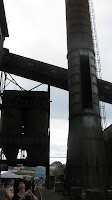Dalek was genuinely surprised this morning. This doesn't happen often when you're of a race that has had emotions genetically modified out it. Searches in the extensive Liberal Party Policy suite have revealed a policy on Global Warming. The Supreme Dalek called for further analysis...
It turns out that it isn't really Coalition policy. The Nats are pretty straightforward on the issue, it ain’t happening and they oppose doing anything about nothing (unless there are grants involved). They would make good Daleks if they weren't such losers.
But the Libs do have a policy (and they always roll the Nats when they are in Government, see for instance various Rural Adjustment Schemes under John Howard that paid Skaro Farmers off but never stopped the inevitable roll of Kaled domination).
Today the Australian Financial Review (AFR) ran their interview with Greg Hunt who expounded on Coalition Policy. Unfortunately the AFR article is behind a paywall, against which a disintegration gun appears to be useless, although some of the juicer bits were exposed:
“But amid calls from business for more details of its direction action policy, opposition climate change spokesman Greg Hunt has revealed a future Coalition government would now issue a white paper after the election to consult on its implementation.”
So if you’re confused by our policy, don’t worry, after we are elected we’ll put it together. Dalek presumes we’ll see the same from Treasury spokesman Joe Hockey and others. Why not just quote Joh-ros and say “Don’t you worry about that” and be done with it?
“… he also now believed the Coalition’s $3.2 billion policy would achieve even more abatement to meet Australia’s 2020 emissions reduction target of 5 per cent through activities like revegetation. This is despite doubts from some experts he claims to have relied to estimate potential abatement.”
Because, believe it or not, the Coalition is actually committed to the same emissions reduction target that Labor is committed to. So he needs to find a policy that can achieve something, and for less than the Carbon Price. Otherwise it’s either a fairly ineffective policy, or a fairly expensive policy for what it does, and someone will be revealed as having no clothes (or at least revealed to have only ever had on a pair of speedos). For those who are interested, the Grattan Institute has estimated the cost at up to $100 billion.
But worry not about the cost, because:
“Of the estimated abatement from the fund, more than 50 per cent (85 million tonnes) is from increased soil carbon.
Mr Hunt said the estimate of potential abatement was based on “real world” estimates from a range of sources, including the Energy Efficiency Council* …He also highlighted a paper by CSIRO scientist Michael Battagalia on the potential of soil carbon to achieve emissions reduction.
“It talks about a 20 per cent reduction in Australia’s emissions per annum on a conservative basis for at least the next 40 years,” Mr Hunt said. “I think that has not been given the importance it deserves.”
But Dr Battaglia … told the AFR that while soil carbon had potential it was not proven how bit that contribution would be to emissions reduction. He said the 20 per cent figure could be achieved after 40 years.
Our assessment is between now and 2020, even with a concerted effort, we could achieve a 5 per cent reduction only with the top end of the range of estimates and a whole range of economic and social considerations such as trade-offs with other land uses, commodity prices,” Dr Battaglia said.
Energy Efficiency Council chief executive also distanced his organisations from the estimates cited by the Coalition.
“Right now it’s unclear if the Coalition’s direction action plan will deliver much energy efficiency””
Dalek is always surprised when the Libs site the CSIRO, given how they have attempted to pwn the organization ever since they embraced the non-science leadership of the followers of Dr Pell. This sort of selective usage could lead to trouble for Greg Hunt, who did after all do his Honors (sic) thesis in Carbon Trading and has had to do his best since to avoid modification. This may explain his confusion of the word “conservative” with optimistic projections that would have made Bob Brown double-check the figures.
Dalek’s recommendation in future is to make sure you cite eminent scientists from the select Universities of Climate Denial (which must surely exist somewhere and are willing to say anything for the promise of a research grant), or Policy organisations run by failed Liberal staffers. Failing that, the mutants and I are sticking to science. But we’re genetically programmed that way…





